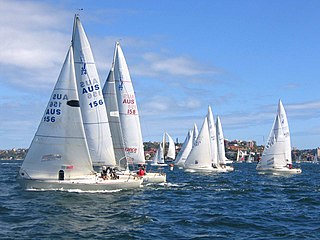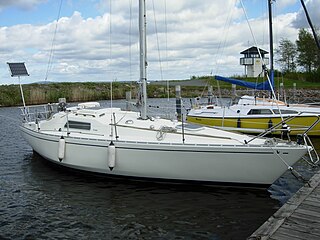Synopsis
IMS was the first yacht racing rule developed around the central idea of a Velocity prediction program (VPP). The VPP was a complex computer program that integrated continuous hullform information in order to predict a given boat's speed potential in a given wind velocity. Details on the VPP were openly available to the yachting community, in contrast to the earlier IOR system. Designers and boat owners much preferred this as they were able to design new yachts to maximise performance under the rule with a degree of certainty they had not enjoyed under the IOR rule. IMS is generally believed to have made significant leaps of progress forward from the IOR rule it displaced in terms of fairness and accuracy.
A velocity prediction program (VPP) is a program which solves for the performance of a sailing yacht in various wind conditions by balancing hull and sail forces. VPPs are used by yacht designers, boat builders, model testers, sailors, sailmakers, also America's Cup teams, to predict the performance of a sailboat before it has been built or prior to major modifications.
IMS racing declined seriously in the early 2000s. A raft of new technology developments in yacht design led to a situation where the very largest and most expensive yachts were able to gain a significant technology advantage which the rule was less able to account for. Smaller yacht owners began to feel unfairly disadvantaged under the rule and between 2003 and 2007 much handicap racing around the world changed to using the newer IRC rule.
However, an improved, revised version of IMS was developed over the years 2006-2008, and known as the Offshore Racing Congress (ORC) rule. As of 2008 some major sailing clubs around the world considered replacing IRC with ORC in their club activities, heralding a return to the IMS system in a more modern form.
The Offshore Racing Congress Rule is a system of handicapping sailboats for the purpose of racing. It is managed by the Offshore Racing Congress (ORC) and is usually referred to in the sailing community simply as "ORC". ORC is an enhanced version of the earlier IMS handicapping system that was used globally from the early 1990s to the early 2000s.
This page is based on this
Wikipedia article Text is available under the
CC BY-SA 4.0 license; additional terms may apply.
Images, videos and audio are available under their respective licenses.

Yacht racing is a form of sport involving sailing yachts and larger sailboats, as distinguished from dinghy racing. It is composed of multiple yachts, in direct competition, racing around a course marked by buoys or other fixed navigational devices or racing longer distances across open water from point-to-point. It can involve a series of races when buoy racing or multiple legs when point-to-point racing.

A maxi yacht usually refers to a racing yacht of at least 70 feet (21 m) in length.

The Rolex Sydney Hobart Yacht Race is an annual event hosted by the Cruising Yacht Club of Australia, starting in Sydney, New South Wales on Boxing Day and finishing in Hobart, Tasmania. The race distance is approximately 630 nautical miles (1,170 km). The race is run in conjunction with the Royal Yacht Club of Tasmania, and is widely considered to be one of the most difficult yacht races in the world.

World Sailing (WS) is the world governing body for the sport of sailing recognized by the International Olympic Committee and the International Paralympic Committee (IPC).
One-Design is a racing method which may be adopted in sports which use complex equipment, whereby all vehicles, gliders or boats have identical or very similar designs or models. In motor racing, it is also known as Spec series, and one-make racing.
Performance Handicap Racing Fleet (PHRF) is a handicapping system used for yacht racing in North America. It allows dissimilar classes of sailboats to be raced against each other. The aim is to cancel out the inherent advantages and disadvantages of each class of boats, so that results reflect crew skill rather than equipment superiority.

The One Ton Cup is a trophy presented to the winner of a sailing competition created in 1899 by the Cercle de la voile de Paris (CVP).

The Contessa 32 is a 9.75 metre (32 ft) fibreglass monohull sailing yacht, designed in 1970 by David Sadler in collaboration with yachtbuilder Jeremy Rogers, as a larger alternative to the Contessa 26. With over 750 hulls built, the yacht has become the most successful one-design cruiser-racer of all time. The yachts have a masthead sloop rig, with a fin keel and a skeg-mounted rudder, a cutting edge concept for the period which now represents a cross between newer and older designs.
IRC is a system of handicapping sailboats and yachts for the purpose of racing. It is managed by the Royal Ocean Racing Club in the United Kingdom through their dedicated Rating Office. and UNCL in France.
The North 26 is a boat designed by Julian D Everitt in 1982, Cowes UK, designer of the very successful E boat. Big brother to the E-boat, intended for Yacht racing Inshore and in Junior Offshore Group races to rate under Channel now IRC measurement rule. Examples race the English Channel and have a wide flat sole plate that enables them to sit the mud in English ports with the keel retracted. This feature also enables safe beach sitting whilst cruising and use as a Trailer yacht.
The Seaway 25 was designed by Doug Peterson of USA fame for Tom Stevenson in 1978 after Tom won the World half Ton championship in one of Doug's designs. The yacht was designed to sail well on the short sharp chop of Port Phillip Bay Melbourne Australia. Intended to rate as a quarter ton Trailer yacht under IOR and Junior Offshore Group racing both for Harbour and Inshore Yacht racing.
The E-Boat, was designed by Julian Everitt, and went into production in 1976 and there are in excess of 250 E-Boats built between 1976 and 1984 of which around one hundred and fifty were in the UK. She was designed to comply with IOR rules and is basically a 22 feet, four berth trailer sailer. The E-Boat Offshore One Design is a light displacement flush deck IOR Mini Ton keel-boat with a lifting cast iron keel, designed in 1974. Most boats sailing are in Great Britain, Ireland, The Netherlands and Denmark.
Svenskt Respitsystem (SRS), formerly known as Leading Yard Stick and Lidingö Yard Stick (LYS). SRS is a semi-empirically based handicapping system used in yacht racing in the Nordic countries. The first version of the handicap system was developed in 1970 by the Swedish yacht designer Lars-Olof Norlin. He based the system on regatta results from the Round Lidingö Race. His own design, Allegro 27, was used as the benchmark and was by definition assigned a LYS value of 1.00.

Sailing as a sport involves a variety of competitive sailing formats that are sanctioned through various sailing federations and yacht clubs. Racing disciplines include matches within a fleet of sailing craft, between a pair thereof or among teams. Additionally, there are specialized competitions that include setting speed records. Racing formats include both closed courses and point-to-point contests; they may be in sheltered waters, coast-wise or on the open ocean. Most competitions are held within defined classes or ratings that either entail one type of sailing craft to ensure a contest primarily of skill or rating the sailing craft to create classifications or handicaps.

Half Ton class was an offshore sailing class of the International Offshore Rule racing the Half Ton Cup between 1967 and 1993.







